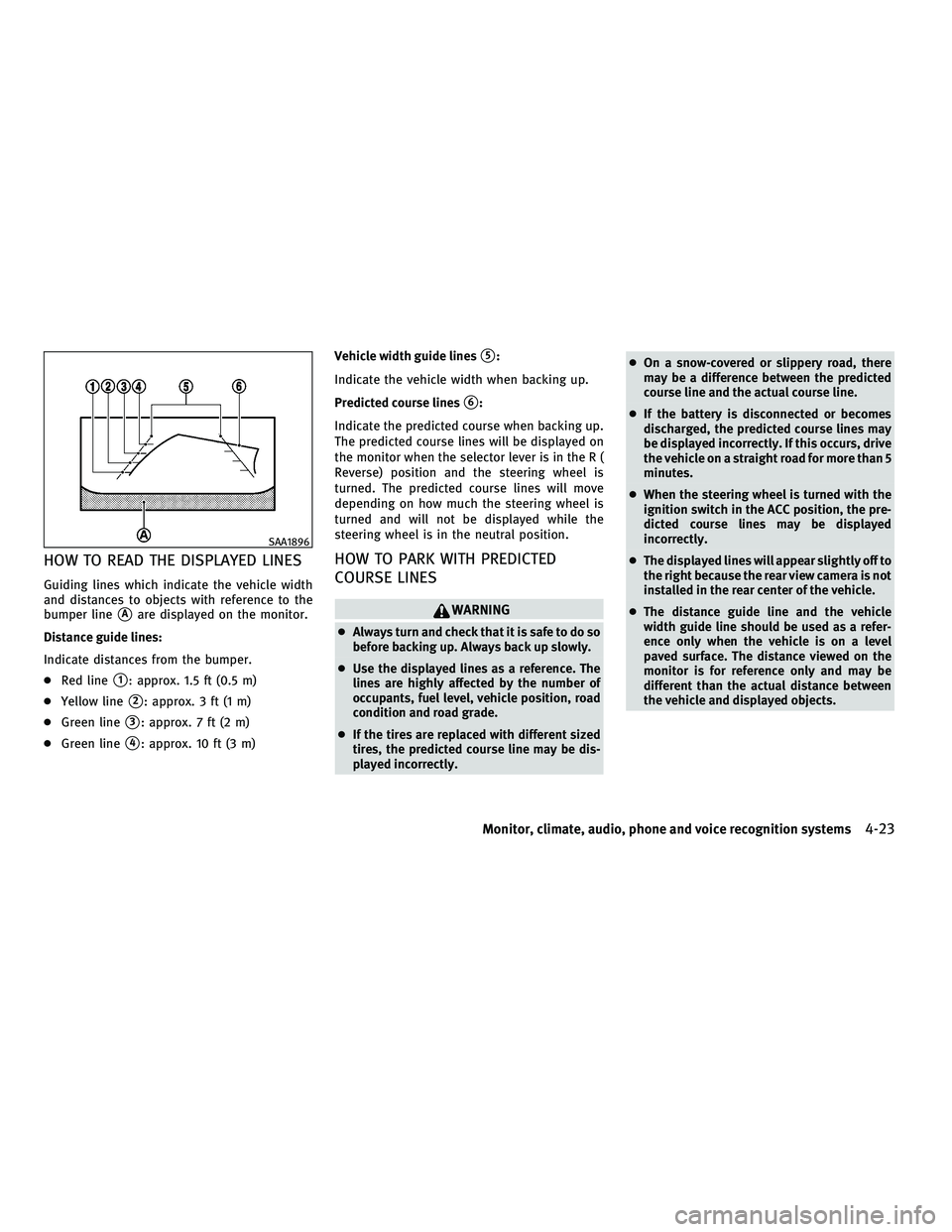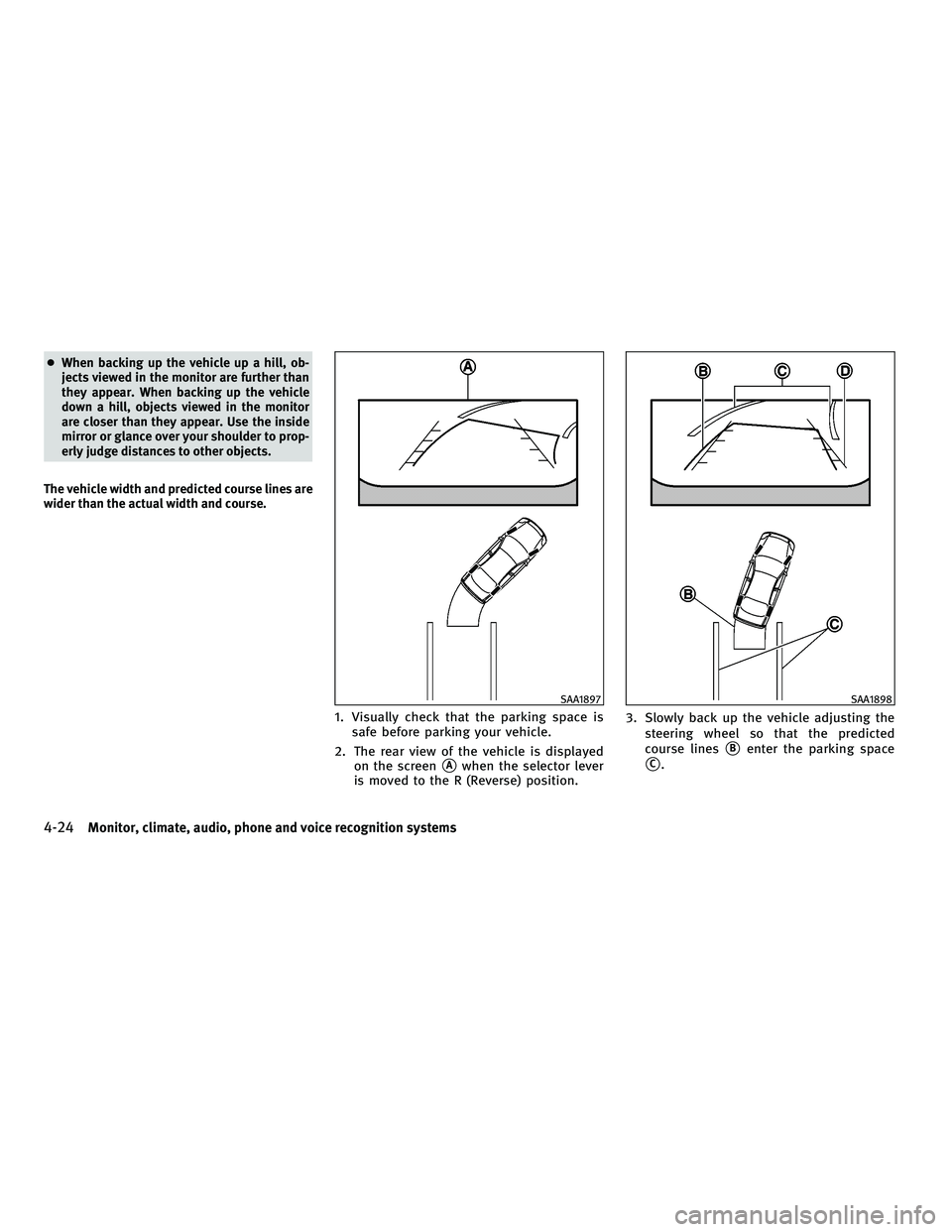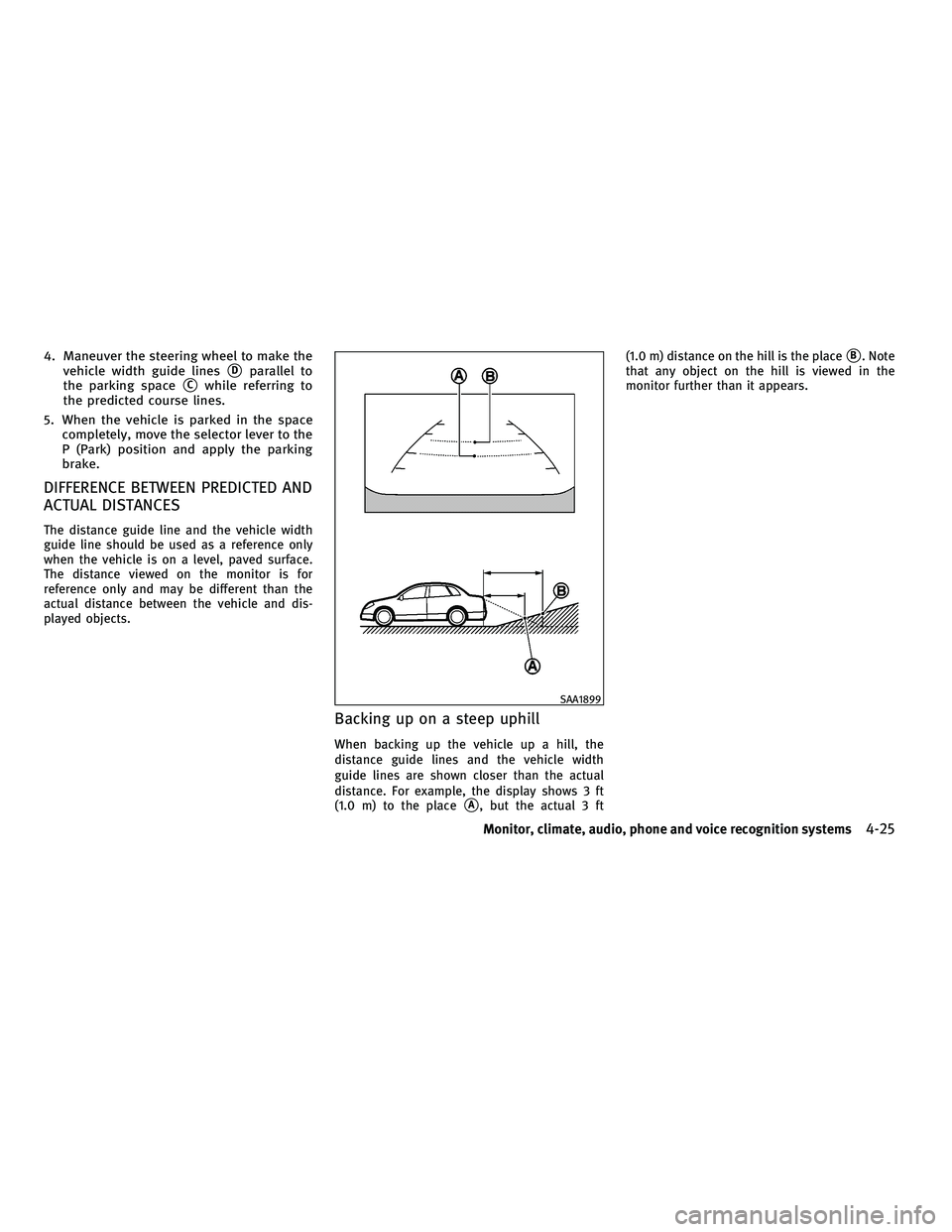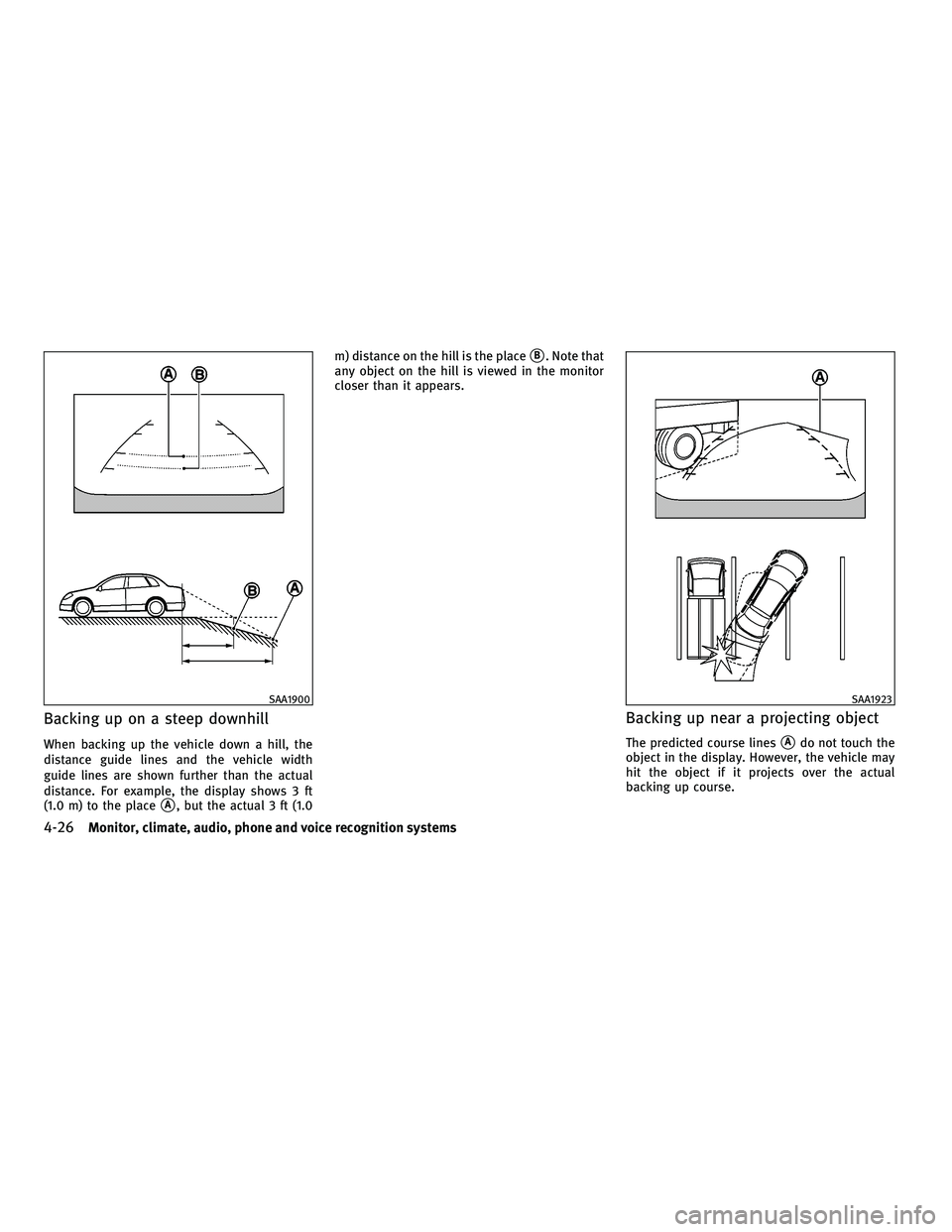width INFINITI M 2010 Owners Manual
[x] Cancel search | Manufacturer: INFINITI, Model Year: 2010, Model line: M, Model: INFINITI M 2010Pages: 445, PDF Size: 6.15 MB
Page 186 of 445

HOW TO READ THE DISPLAYED LINES
Guiding lines which indicate the vehicle width
and distances to objects with reference to the
bumper line
sAare displayed on the monitor.
Distance guide lines:
Indicate distances from the bumper.
c Red line
s1: approx. 1.5 ft (0.5 m)
c Yellow line
s2: approx. 3 ft (1 m)
c Green line
s3: approx. 7 ft (2 m)
c Green line
s4: approx. 10 ft (3 m) Vehicle width guide lines
s5:
Indicate the vehicle width when backing up.
Predicted course lines
s6:
Indicate the predicted course when backing up.
The predicted course lines will be displayed on
the monitor when the selector lever is in the R (
Reverse) position and the steering wheel is
turned. The predicted course lines will move
depending on how much the steering wheel is
turned and will not be displayed while the
steering wheel is in the neutral position.
HOW TO PARK WITH PREDICTED
COURSE LINES
WARNING
c Always turn and check that it is safe to do so
before backing up. Always back up slowly.
c Use the displayed lines as a reference. The
lines are highly affected by the number of
occupants, fuel level, vehicle position, road
condition and road grade.
c If the tires are replaced with different sized
tires, the predicted course line may be dis-
played incorrectly. c
On a snow-covered or slippery road, there
may be a difference between the predicted
course line and the actual course line.
c If the battery is disconnected or becomes
discharged, the predicted course lines may
be displayed incorrectly. If this occurs, drive
the vehicle on a straight road for more than 5
minutes.
c When the steering wheel is turned with the
ignition switch in the ACC position, the pre-
dicted course lines may be displayed
incorrectly.
c The displayed lines will appear slightly off to
the right because the rear view camera is not
installed in the rear center of the vehicle.
c The distance guide line and the vehicle
width guide line should be used as a refer-
ence only when the vehicle is on a level
paved surface. The distance viewed on the
monitor is for reference only and may be
different than the actual distance between
the vehicle and displayed objects.
SAA1896
Monitor, climate, audio, phone and voice recognition systems4-23
wÐ
Ð
05/14/09Ðpattie
X
Page 187 of 445

cWhen backing up the vehicle up a hill, ob-
jects viewed in the monitor are further than
they appear. When backing up the vehicle
down a hill, objects viewed in the monitor
are closer than they appear. Use the inside
mirror or glance over your shoulder to prop-
erly judge distances to other objects.
The vehicle width and predicted course lines are
wider than the actual width and course.
1. Visually check that the parking space is safe before parking your vehicle.
2. The rear view of the vehicle is displayed on the screen
sAwhen the selector lever
is moved to the R (Reverse) position. 3. Slowly back up the vehicle adjusting the
steering wheel so that the predicted
course linessBenter the parking space
sC.
SAA1897SAA1898
4-24Monitor, climate, audio, phone and voice recognition systems
wÐ
Ð
05/14/09Ðpattie
X
Page 188 of 445

4. Maneuver the steering wheel to make thevehicle width guide lines
sDparallel to
the parking space
sCwhile referring to
the predicted course lines.
5. When the vehicle is parked in the space completely, move the selector lever to the
P (Park) position and apply the parking
brake.
DIFFERENCE BETWEEN PREDICTED AND
ACTUAL DISTANCES
The distance guide line and the vehicle width
guide line should be used as a reference only
when the vehicle is on a level, paved surface.
The distance viewed on the monitor is for
reference only and may be different than the
actual distance between the vehicle and dis-
played objects.
Backing up on a steep uphill
When backing up the vehicle up a hill, the
distance guide lines and the vehicle width
guide lines are shown closer than the actual
distance. For example, the display shows 3 ft
(1.0 m) to the place
sA, but the actual 3 ft (1.0 m) distance on the hill is the place
sB. Note
that any object on the hill is viewed in the
monitor further than it appears.
SAA1899
Monitor, climate, audio, phone and voice recognition systems4-25
wÐ
Ð
05/14/09Ðpattie
X
Page 189 of 445

Backing up on a steep downhill
When backing up the vehicle down a hill, the
distance guide lines and the vehicle width
guide lines are shown further than the actual
distance. For example, the display shows 3 ft
(1.0 m) to the place
sA, but the actual 3 ft (1.0m) distance on the hill is the place
sB. Note that
any object on the hill is viewed in the monitor
closer than it appears.
Backing up near a projecting object
The predicted course linessAdo not touch the
object in the display. However, the vehicle may
hit the object if it projects over the actual
backing up course.
SAA1900SAA1923
4-26Monitor, climate, audio, phone and voice recognition systems
wÐ
Ð
05/14/09Ðpattie
X
Page 204 of 445

Troubleshooting guide :
SymptomCause and Countermeasure
Cannot play Check if the CD/CF was inserted correctly.
Check if the CD/CF is scratched or dirty.
Check if there is condensation inside the player, and if there is, wait until the condensation is gone (about 1 hour)
before using the player.
If there is a temperature increase error, the player will play correctly after it returns to the normal temperature.
If there is a mixture of music CD files (CD-DA data) and MP3/WMA files on a CD, only the music CD files (CD-DA
data) will be played.
Files with extensions other than ª.MP3º, ª.WMAº, ª.mp3º or ª.wmaº cannot be played. In addition, the character
codes and number of characters for folder names and file names should be in compliance with the specifications.
Check if the disc or the file is generated in an irregular format. This may occur depending on the variation or the
setting of MP3/WMA writing applications or other text editing applications.
Check if the finalization process, such as session close and disc close, is done for the disc.
Check if the CD/CF is protected by copyright.
Poor sound quality Check if the CD/CF is scratched or dirty.
It takes a relatively long time before
the music starts playing. If there are many folder or file levels on the MP3/WMA CD/CF, or if it is a multisession disc, some time may be
required before the music starts playing.
Music cuts off or skips The writing software and hardware combination might not match, or the writing speed, writing depth, writing
width, etc., might not match the specifications. Try using the slowest writing speed.
Skipping with high bit rate files Skipping may occur with large quantities of data, such as for high bit rate data.
Move immediately to the next song
when playing. When a non-MP3/WMA file has been given an extension of ª.MP3º, ª.WMAº, ª.mp3º or ª.wmaº, or when play is
prohibited by copyright protection, the player will skip to the next song.
The songs do not play back in the
desired order. The playback order is the order in which the files were written by the writing software, so the files might not play
in the desired order.
Monitor, climate, audio, phone and voice recognition systems4-41
wÐ
Ð
05/14/09Ðpattie
X
Page 305 of 445

cThe LDP system will not operate at speeds
below approximately 45 MPH 72 km/h) or if it
cannot detect lane markers.
c The LDP system may not function properly
under the following conditions, and do not
use the LDP system:
± During bad weather (rain, fog, snow, wind, etc.).
± When driving on slippery roads, such as on ice or snow, etc.
± When driving on winding or uneven roads.
± When there is a lane closure due to road repairs.
± When driving in a makeshift lane.
± When driving on roads where the lane width is too narrow.
± When driving without normal tire condi- tions (for example, tire wear, low tire
pressure, installation of spare tire, tire
chains, non-standard wheels).
± When the vehicle is equipped with non- original brake parts or suspension parts. c
If the LDP system malfunctions, it will cancel
automatically. The lane departure warning
light (orange) on the instrument panel will
illuminate.
c If the lane departure warning light (orange)
illuminates, pull off the road to a safe loca-
tion and stop the vehicle. Turn the engine off
and restart the engine. If the warning light
(orange) continues to illuminate, have the
LDP system checked by an INFINITI retailer.
c Excessive noise will interfere with the warn-
ing chime sound, and the chime may not be
heard.
The functions of the LDP system (warning and
brake control assist) may or may not operate
properly under the following conditions:
c On roads where there are multiple parallel
lane markers; lane markers that are faded or
not painted clearly; yellow painted lane
markers; non-standard lane markers; or lane
markers covered with water, dirt, snow, etc.
c On roads where discontinued lane markers
are still detectable.
c On roads where there are sharp curves.
c On roads where there are sharply contrast-
ing objects, such as shadows, snow, water, wheel ruts, seams or lines remaining after
road repairs. (The LDP system could detect
these items as lane markers.)
c On roads where the traveling lane merges or
separates.
c When the vehicle's traveling direction does
not align with the lane marker.
c When traveling close to the vehicle in front
of you, which obstructs the lane camera unit
detection range.
c When rain, snow or dirt adheres to the
windshield in front of the lane camera unit.
c When the headlights are not bright due to
dirt on the lens or if the aiming is not
adjusted properly.
c When strong light enters the lane camera
unit. (For example, the light directly shines
on the front of the vehicle at sunrise or
sunset.)
c When a sudden change in brightness occurs.
(For example, when the vehicle enters or
exits a tunnel or under a bridge.)
While the LDP system is operating, you may
hear a sound of brake operation. This is normal
and indicates that the LDP system is operating
properly.
5-20Starting and driving
wÐ
Ð
05/15/09Ðpattie
X
Page 403 of 445

TIRE LABELING
Federal law requires tire manufacturers
to place standardized information on the
sidewall of all tires. This information
identifies and describes the fundamen-
tal characteristics of the tire and also
provides the tire identification number
(TIN) for safety standard certification.
The TIN can be used to identify the tire in
case of a recall.
s1Tire size (example: P215/60R16 94H)
1.P: The ªPº indicates the tire is de-
signed for passenger vehicles. (Not all
tires have this information.)
2.Three-digit number (215): This num-
ber gives the width in millimeters of
the tire from sidewall edge to side-
wall edge.
3.Two-digit number (60): This number,
known as the aspect ratio, gives the
tire's ratio of height to width.
4.R: The ªRº stands for radial.
5.Two-digit number (16): This number is
the wheel or rim diameter in inches.
6.Two- or three-digit number (94): This
number is the tire's load index. It is a
measurement of how much weight
each tire can support. You may not
find this information on all tires be-
cause it is not required by law.
7.H: Tire speed rating. You should not
drive the vehicle faster than the tire
speed rating.
Example
SDI1575
Example
SDI1606
8-38Maintenance and do-it-yourself
wÐ
Ð
05/15/09Ðpattie
X
Page 421 of 445

DIMENSIONS AND WEIGHTS
Overall length
(without front license plate) in (mm) 194.0 (4,928)
(with front license plate) in (mm) 194.3 (4,935)
Overall width in (mm) 71.1 (1,805)
Overall height in (mm) 59.4 (1,510)*160.1 (1,523)*2
Front tread in (mm) 60.5 (1,537)*1, *3 60.3 (1,532)*1, *4
61.1 (1,551)*2
Rear tread in (mm) 61.0 (1,550)*1, *3 60.8 (1,545)*1, *4
60.7 (1,543)*2
Wheelbase in (mm) 114.2 (2,900)
Gross Vehicle Weight Rating (GVWR) lb (kg) See the F.M.V.S.S. or C.M.V. S.S. certification label on the
driver's side center pillar.
Gross Axle Weight Rating (GAWR)
Front lb (kg)
Rear lb (kg)
*1: Two-Wheel Drive (2WD) model
*2: All-Wheel Drive (AWD) model
*3: P245/45R18 tire equipped model
*4: 245/40R19 tire equipped model When planning to travel in another country,
you
should first find out if the fuel available is
suitable for your vehicle's engine.
Using fuel with an octane rating that is too low
may cause engine damage. All gasoline ve-
hicles must be operated with unleaded gaso-
line. Therefore, avoid taking your vehicle to
areas where appropriate fuel is not available.
When transferring the registration of your ve-
hicle to another country, state, province or dis-
trict, it may be necessary to modify the vehicle
to meet local laws and regulations.
The laws and regulations for motor vehicle
emission control and safety standards vary
according to the country, state, province or
district; therefore, vehicle specifications may
differ.
When any vehicle is to be taken into another
country, state, province or district and regis-
tered, its modifications, transportation, and reg-
istration are the responsibility of the user.
INFINITI is not responsible for any inconvenience
that may result.
WHEN TRAVELING OR REGISTERING YOUR
VEHICLE IN ANOTHER COUNTRY
9-10Technical and consumer information
wÐ
Ð
05/15/09Ðpattie
X
Page 430 of 445

Towing your vehicle with all four wheels on the
ground is sometimes called flat towing. This
method is sometimes used when towing a
vehicle behind a recreational vehicle, such as a
motor home.
CAUTION
cFailure to follow these guidelines can result
in severe transmission damage.
c Whenever flat towing your vehicle, always
tow forward, never backward.
c DO NOT tow any automatic transmission ve-
hicle with all four wheels on the ground (flat
towing). Doing so WILL DAMAGE internal
transmission parts due to lack of transmis-
sion lubrication.
c DO NOT tow an All-Wheel Drive (AWD) ve-
hicle with any of the wheels on the ground.
Doing so may cause serious and expensive
damage to the powertrain.
c For emergency towing procedures refer to
ªTOWING RECOMMENDED BY INFINITIº in the
ª6. In case of emergencyº section of this
manual.
AUTOMATIC TRANSMISSION
All-Wheel Drive (AWD) models
Do not tow an AWD vehicle with any of the
wheels on the ground.
Two-Wheel Drive (2WD) models
To tow a vehicle equipped with an automatic
transmission, an appropriate vehicle dolly
MUST be placed under the towed vehicle's drive
wheels. Alwaysfollow the dolly manufacturer's
recommendations when using their product. DOT (Department Of Transportation) Quality
Grades: All passenger car tires must conform to
federal safety requirements in addition to these
grades.
Quality grades can be found where applicable
on the tire sidewall between tread shoulder and
maximum section width. For example:
Treadwear 200 Traction AA Temperature A
TREADWEAR
The treadwear grade is a comparative rating
based on the wear rate of the tire when tested
under controlled conditions on a specified gov-
ernment test course. For example, a tire graded
150 would wear one and one-half (1 1/2) times
as well on the government course as a tire
graded 100. The relative performance of tires
depends upon actual conditions of their use,
however, and may depart significantly from the
norm due to variations in driving habits, service
practices and differences in road characteristics
and climate.
FLAT TOWING
UNIFORM TIRE QUALITY GRADING
Technical and consumer information9-19
wÐ
Ð
05/15/09Ðpattie
X